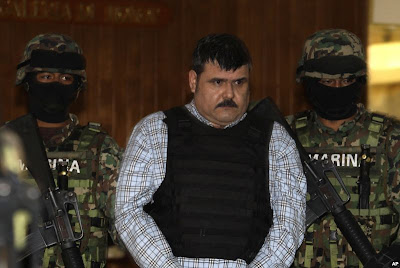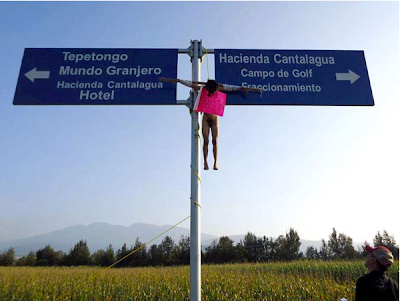Posted and translated in Borderland Beat Forum by AJ
Minor editing by staff
The arrest of Jose Eduardo Costilla Sanchez "El Coss", by the Navy Department, marks the end of a command structure in the criminal organization of the Gulf Cartel (CDG), which may lead to a new leadership from a person that is based in the city of Reynosa, Tamaulipas.
Different versions point to Mario Armando Ramírez Treviño, alias "X-20" or "Pelon" as the new head of the CDG, who is a main distributor of the trafficking of marijuana and cocaine to the U.S. from the border of Tamaulipas.
Mario Ramírez Treviño came to the spotlight on September 2011 of authorities on both sides of the border after the execution of Samuel Flores Borrego "Metro 3", leader of the Gulf Cartel in the Reynosa area, who's death was attributed to Juan Mejía Gonzalez "R-1", and Rafael Cardenas Vela "El Junior," both members of the Gulf Cartel's cell group "Los Rojos" who are in an internal struggle with "Los Metros" for control of the organization.
Unconfirmed versions mention that Jose Eduardo Costilla Sanchez "El Coss", maintained control of the group "Rojos", while the "Metros" kept their loyalty to Osiel Cardenas Guillen (imprisoned in the United States), who had managed to retain control of CDG through his brother Antonio Cardenas "Tony Tormenta" (killed in November 2010), and Mario Cardenas Guillen "El Gordo", arrested by the Navy on September 3rd in Altamira, Tamaulipas.
"X- 20 "took over the 'Plaza' in the middle of the fight between the Gulf Cartel and Los Zetas, for control of the border between Tamaulipas and southern Texas, which includes the municipalities of Reynosa, Nuevo Laredo, Miguel Alemán and Matamoros.
He managed to keep off the radar screen from authorities as he climbed up the ladder of the organization. He managed to win the trust of Jaime González Durán "El Hummer", founding member of Los Zetas, when this group served as the "armed wing" of the Gulf Cartel. "El Hummer" was arrested in November 2008 and is currently serving a sentence of 35 years in prison in the Penal del Altiplano.
After the break between the two organizations, "X-20" was included into the ranks of the Gulf Cartel, as number (Two) of the plaza of Reynosa.
Upon being appointed the 'Plaza' Leader, he was placed on the list of most wanted criminals from the Department of Justice of the United States, who provided a 5 million dollars for any information that would lead to his capture. The Attorney General's Office is now offering a reward of 30 million dollars for his capture.
In March of this year, La Jornada published a news story about private conversations that were taped from a period of 90 to 180 days that had revealed that "X-20" had become a leader of the Gulf Cartel. His name appeared on a list of records of persons subjected to surveillance by the agency of the Mexican Ministry of Interior.
On August 29th, in Nuevo Leon, a group of criminals kidnapped and killed four people in the community of Mitras Norte in Monterrey. This was part of a violent escalation that went on for 48 hours that left a toll of 33 people dead. Authorities attributed it to the settling of scores between the cartel. In particular the quadruple homicide in Mitras Norte, where a group of gunmen left a narcomensaje, which read:
"Comandante X20 presente CDG"
What could be taken as a message to the cells operating in the state, before a possible change of command in the organization. A week later, Mario Cardenas Guillen "El Gordo" was arrested. Media reports say that the split between "Rojos" and "Metros" moved to the upper echelons of the Gulf Cartel, causing the breakdown between Cárdenas Guillén and Jose Eduardo Costilla Sanchez "El Coss", and the capture of "El Gordo" would mean the end of the split, restoring the chain of command through Mario Armando Ramírez Treviño, alias "X-20" or "Pelon".
The current circumstantial rearrangements within the CDG poses the potential of future intensifications of criminal activities among all the cartels including Los Zetas who are looking to assume full control of Tamaulipas and Nuevo Leon, and a likely intervention from the Sinaloa Cartel who may now seek to expand it's operations to the Gulf and thus, establish itself as the leading criminal organization in Mexico.
Original source: Vanguardia
Minor editing by staff
Different versions point to Mario Armando Ramírez Treviño, alias "X-20" or "Pelon" as the new leader of the Gulf Cartel.
Different versions point to Mario Armando Ramírez Treviño, alias "X-20" or "Pelon" as the new head of the CDG, who is a main distributor of the trafficking of marijuana and cocaine to the U.S. from the border of Tamaulipas.
Mario Ramírez Treviño came to the spotlight on September 2011 of authorities on both sides of the border after the execution of Samuel Flores Borrego "Metro 3", leader of the Gulf Cartel in the Reynosa area, who's death was attributed to Juan Mejía Gonzalez "R-1", and Rafael Cardenas Vela "El Junior," both members of the Gulf Cartel's cell group "Los Rojos" who are in an internal struggle with "Los Metros" for control of the organization.
Unconfirmed versions mention that Jose Eduardo Costilla Sanchez "El Coss", maintained control of the group "Rojos", while the "Metros" kept their loyalty to Osiel Cardenas Guillen (imprisoned in the United States), who had managed to retain control of CDG through his brother Antonio Cardenas "Tony Tormenta" (killed in November 2010), and Mario Cardenas Guillen "El Gordo", arrested by the Navy on September 3rd in Altamira, Tamaulipas.
"X- 20 "took over the 'Plaza' in the middle of the fight between the Gulf Cartel and Los Zetas, for control of the border between Tamaulipas and southern Texas, which includes the municipalities of Reynosa, Nuevo Laredo, Miguel Alemán and Matamoros.
He managed to keep off the radar screen from authorities as he climbed up the ladder of the organization. He managed to win the trust of Jaime González Durán "El Hummer", founding member of Los Zetas, when this group served as the "armed wing" of the Gulf Cartel. "El Hummer" was arrested in November 2008 and is currently serving a sentence of 35 years in prison in the Penal del Altiplano.
After the break between the two organizations, "X-20" was included into the ranks of the Gulf Cartel, as number (Two) of the plaza of Reynosa.
Upon being appointed the 'Plaza' Leader, he was placed on the list of most wanted criminals from the Department of Justice of the United States, who provided a 5 million dollars for any information that would lead to his capture. The Attorney General's Office is now offering a reward of 30 million dollars for his capture.
In March of this year, La Jornada published a news story about private conversations that were taped from a period of 90 to 180 days that had revealed that "X-20" had become a leader of the Gulf Cartel. His name appeared on a list of records of persons subjected to surveillance by the agency of the Mexican Ministry of Interior.
On August 29th, in Nuevo Leon, a group of criminals kidnapped and killed four people in the community of Mitras Norte in Monterrey. This was part of a violent escalation that went on for 48 hours that left a toll of 33 people dead. Authorities attributed it to the settling of scores between the cartel. In particular the quadruple homicide in Mitras Norte, where a group of gunmen left a narcomensaje, which read:
"Comandante X20 presente CDG"
What could be taken as a message to the cells operating in the state, before a possible change of command in the organization. A week later, Mario Cardenas Guillen "El Gordo" was arrested. Media reports say that the split between "Rojos" and "Metros" moved to the upper echelons of the Gulf Cartel, causing the breakdown between Cárdenas Guillén and Jose Eduardo Costilla Sanchez "El Coss", and the capture of "El Gordo" would mean the end of the split, restoring the chain of command through Mario Armando Ramírez Treviño, alias "X-20" or "Pelon".
The current circumstantial rearrangements within the CDG poses the potential of future intensifications of criminal activities among all the cartels including Los Zetas who are looking to assume full control of Tamaulipas and Nuevo Leon, and a likely intervention from the Sinaloa Cartel who may now seek to expand it's operations to the Gulf and thus, establish itself as the leading criminal organization in Mexico.
Original source: Vanguardia





























